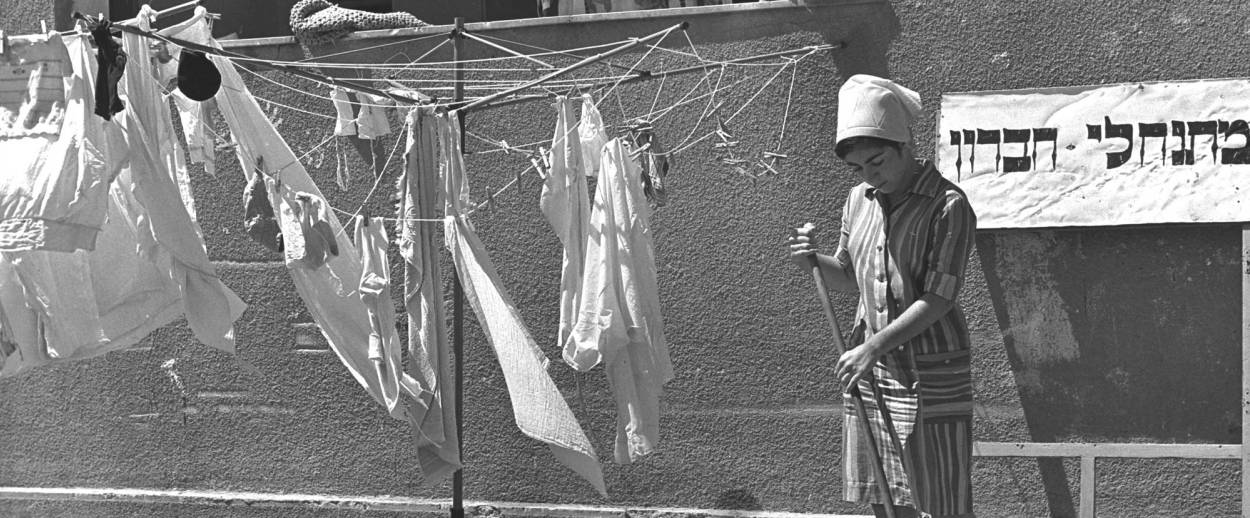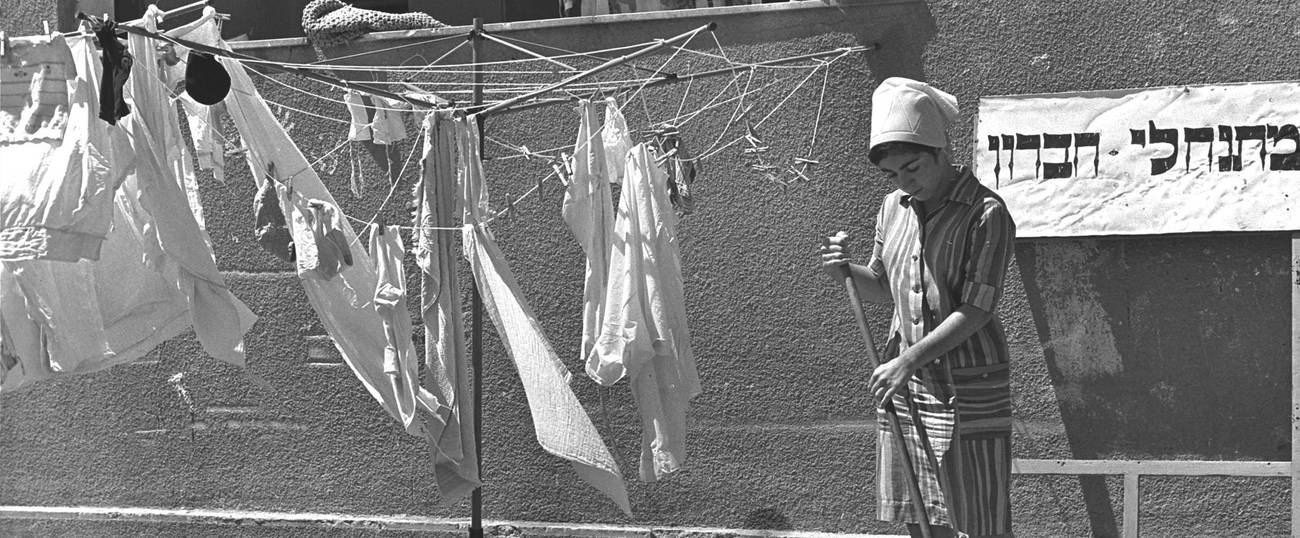Are Right-Wing American Jewish Settlers Destroying Zionism?
A new history, City on a Hilltop, looks at the huge range of political affiliations that have animated people to occupy land in and around Israel




In 1848, while visiting England, Ralph Waldo Emerson heard a rumor about Alfred, Lord Tennyson, soon to become poet laureate and in great demand as a dinner guest. Tennyson had apparently agreed to a country-house weekend on three conditions: that he could smoke in the house, not have to come down to breakfast, and not hear any talk about the Irish question.
Nowadays Tennyson’s third condition would doubtless be “no discussion of the Israel-Palestine question.” Nothing has ruined more dinner parties than the clichéd yelling match during which one Jew insists that the obstacle to peace is Arab intransigence while the other sees Israeli settlements as an unforgivable sin.
If you think “the occupation” is the chief devil of modern Jewish existence, your stereotype of the settler might well be a religious Jew from Brooklyn—the true center of low-rent fanaticism—who enjoys setting fire to Palestinian olive groves. But Sara Yael Hirschhorn’s new book, City on a Hilltop, a history of American-Israeli settlers, argues that they have always been a diverse bunch: secular, liberal, conservative, religious, and everything in between.
Hirschhorn begins by noting that Americans are overrepresented in the West Bank: They make up about 15 percent of the roughly 400,000 settlers. The huge majority of the first generation of American settlers were young and left-leaning; many fought for civil rights and against the Vietnam War. Only 2 percent were Republicans. Settlement-building was often an extension of their liberal activism: Hirschhorn writes that their “desire to ‘make a difference’ inspired them to establish their own communities beyond the Green Line.”
The Six-Day War awakened the first wave of American settlers from their suburban slumbers: 99 percent of American Jews supported Israel against the Arab armies vowing to push the Jews into the sea. Nancy Weber announced in the Village Voice a few days after the war: “Two weeks ago, Israel was a they; now Israel is a we.” But what could American Jews do for Israel, since it had defended itself so capably against the Arabs? The answer—so it seemed to the American settlers—was to act boldly to expand Israel’s boundaries, just as the early Zionists had done. Hirschhorn’s interviewees, at their most self-glorifying, see themselves as akin to Trumpeldor at Tel Hai or the halutzim of Degania Alef: Zionist trailblazers. After all, Britain under the mandate tried to prevent Jewish immigration and called it illegal. What’s illegal today will be celebrated tomorrow, the settlers imply.
An American-Israeli couple first came up with the idea of re-establishing a Jewish presence in the heart of the West Bank. During Passover 1968, Rabbi Moshe Levinger and his wife, Miriam, rented a hotel for 10 days in the center of Hebron, where Jews had lived continuously from Biblical times until the 1948 War of Independence. Hebron was the site of the infamous 1929 massacre of the city’s Jews by Arabs protesting renewed Jewish settlement in Palestine. Invited by the Levingers, 30 families decided to stay. In 1971, the government relocated them to Kiryat Arba, a former military base on the fringes of the city. But in 1979, Miriam Levinger smuggled a group of 50 women and children back into downtown Hebron. Prime Minister Menachem Begin let them stay, despite vigorous Palestinian objections. Both Levingers spent time in jail, Moshe for killing a Palestinian shopkeeper along with a string of other violent acts, and Miriam for attacking a police officer.
Hebron was, of course, the home of Baruch Goldstein, who, by murdering 29 Muslim worshippers in 1994, forever changed the image of American-born Israeli settlers. Goldstein had attended the Yeshiva of Flatbush and was as home-grown a Jewish Brooklynite as one could imagine. After the massacre, Prime Minister Yitzhak Rabin memorably denounced Goldstein as a poisonous “foreign implant.” The Israeli media, across the political spectrum, chimed in with denunciations of America’s religious fanatics. The rabid Jewish-American settler entered the realm of mythology, most memorably in Philip Roth’s The Counterlife, where a gun-toting, foaming-at-the-mouth rabbi gives long speeches about not knuckling under to the goyim.
Yet the mythic image, Hirschhorn demonstrates, is distant from reality. There were nonreligious settlers too among the Americans, notably in Yamit, a town in the Sinai that was built from scratch in 1975 against a starkly beautiful setting of palm trees, sand, and ocean. Dismantled as a result of Israeli-Egyptian peace negotiations in 1982, Yamit was a close-knit community of about 2,500 that apparently dabbled in free love: One resident interviewed by Hirschhorn, Carole Rosenblatt, reported that there was a swingers circle in the town. When the news came that Yamit was to be destroyed, a wave of divorces and suicides hit the settlement.
Efrat, another settlement built by Americans, was established in the early 1980s in Gush Etzion, where Arab forces massacred over a hundred Jews when they took the area in 1948. Gush Etzion, at that time full of religious Zionists, had suffered greatly from the Arab blockade of Jerusalem. After 1967 many Israelis viewed the area as liberated Jewish territory, since Jews had lived there during the British Mandate.
Efrat’s spiritual leader was, and still is, Rabbi Shlomo Riskin, who left the Upper West Side’s Lincoln Square Synagogue for a West Bank locale that as of 1980 was still more fantasy than reality for American Jews. In that year, Riskin’s mother-in-law wrote to his mother, “They took us to this empty mountaintop … without a living soul. Your son and my daughter looked pleased as punch, as if they were showing off Switzerland, Paris, and New York all rolled into one …. they’re living in a Peter Pan, Alice in Wonderland dream world.”
Efrat currently houses about 9,000 residents, half of them native English speakers. Riskin refused to join Gush Emunim, the religious settlers’ movement, and he has been adamant that Efrat seized no private Palestinian land, despite newspaper reports and lawsuits suggesting the contrary. “I didn’t come like a thief at night,” he told Hirschhorn. “We first checked every inch, we made sure this was Jewish land.”
Though he has a reputation as a liberal, Riskin stands opposed to a Palestinian state anywhere in the West Bank. He sees his settlers as the heirs of the civil-rights movement and has pledged himself to nonviolent resistance if the government ever tries to dismantle Efrat. “I marched in Selma with Martin Luther King,” Riskin says. “Now we, the settlers, have become the blacks of Martin Luther King.”
Riskin can be contrasted to Menachem Froman, the stubbornly righteous rabbi of Tekoa, a settlement founded in 1979 by 10 squatters that now contains over 600 families. Tekoa was started by Americans, but Froman, who died in 2013, was from the Galilee; he was famous for his willingness to talk to anyone, including the leaders of Hamas. Bearing his kosher hummus and pita in a plastic bag, Froman made his name by breaking bread with the sworn enemies of the Jewish state. He wasn’t interested, he said, in who governed the land; instead, he sought peace between Arabs and Jews.
Froman marched against Jewish terrorism in Judea and Samaria, and he doggedly pursued religious dialogue with Muslims. But his path, heroic as it was, cannot by itself heal the rift between Israelis and Palestinians. For years, as you approached Froman’s house, you could see graffiti announcing “PLO—Tekoa branch”; and some of Hirschhorn’s interviewees grumble about what they call his naïveté and publicity-seeking.
Hirschhorn’s point of view, though implicit, seems clear enough: along with most of the world, including many Israelis, she doesn’t think it is desirable for Jews to be living throughout the occupied territories. She sprinkles her book with sharp comments about the settlers’ willful ignorance of Arab land rights, but she can be a softy at times. She writes about one Hebron resident, “Malka Chaiken is not a monster: She’s a very mild-mannered, middle-aged woman who reminds me a little of my mom.” The settlers she interviews say that Jews have the right to live anywhere: but, as she points out, talking about one’s “rights” is not enough. One person’s rights often conflict with another’s, and preventing a new intifada is reason enough to block someone’s right to build a house on a hilltop.
As Gadi Taub argued in his book The Settlers, the effort to people the West Bank with Jews shows a serious misunderstanding of Zionism, one shared by most of the settlers that Hirschhorn interviews. Taub remarks that Zionism was never about insisting on the Jewish right to biblical lands. Instead, Zionists focused on Jewish self-determination, which in theory could have happened anywhere. The Zionist movement chose Palestine not because Jews had a religious duty to reclaim the land, but because it was by far the most fitting site for the Jewish nation, a galvanizing symbol for millions of people in need of a homeland.
The Zionist choice was, in fact, correct: Palestine, the hinge between East and West, turned out to be a uniquely apt place to reunite the Ashkenazi and Mizrahi halves of the Jewish nation, which would have surely had a much harder time justifying its existence in, say, Uganda. Ironically, the settlements have turned Israelis back into a quasi-European colonial power imposing its will on the natives.
The temptation among Israelis is to think of settlements as a nearly incidental fact about their country. It’s true that the settlers make up only about 5 percent of Israel’s population, and most of them live in blocs close to the Green Line that will likely always be part of Israel: in Hirschhorn’s terms they are hardly settlers at all. But Palestinian anger rightly feeds off the fact that Israel favors the interests of West Bank Jews over Arabs: After all, the Jews are citizens and voters. Sooner or later, the imbalance must be corrected, or Israel will face another revolt.
In 2006, Ehud Olmert ran for prime minister, and won, after proposing to unilaterally give up 88 percent of the West Bank and withdraw all Israeli citizens behind the security barrier; two years later, Olmert offered Mahmoud Abbas a little over 93 percent of the West Bank as part of a final status agreement. But times have changed: The “peace process” has been dead for at least a decade, despite its zombie-like reanimation during the Obama presidency, but that doesn’t mean that Israel can do nothing for peace: It can unilaterally dismantle some existing settlements.
Forfeiting the rights of tens of thousand Jews to live in Judea and Samaria would be a small price to pay for the long-term advantage that could come from Israel’s reduced profile in the territories. After a decade of Hamas rule in Gaza, the Israeli public fears, and with some cause, that giving up territory invites an endless state of war. But is there any reasonable alternative?
Political change will at some point come to the West Bank whatever Israel does, though no one can predict what shape it will take. Political prophecy is a mug’s game. But as Hirschhorn shows in City on a Hilltop, we can at least know a dead end when we see it.
***
David Mikics last wrote for Tablet magazine about Laura Kipnis’s book on Title IX campus witch hunts, Unwanted Advances.
David Mikics is the author, most recently, of Stanley Kubrick (Yale Jewish Lives). He lives in Brooklyn and Houston, where he is John and Rebecca Moores Professor of English at the University of Houston.